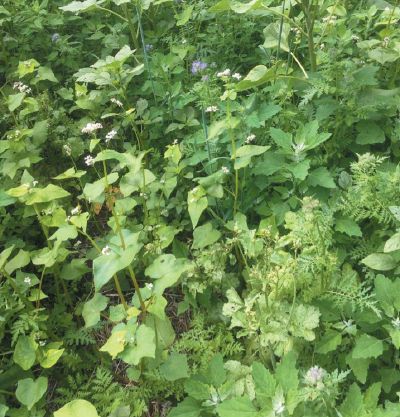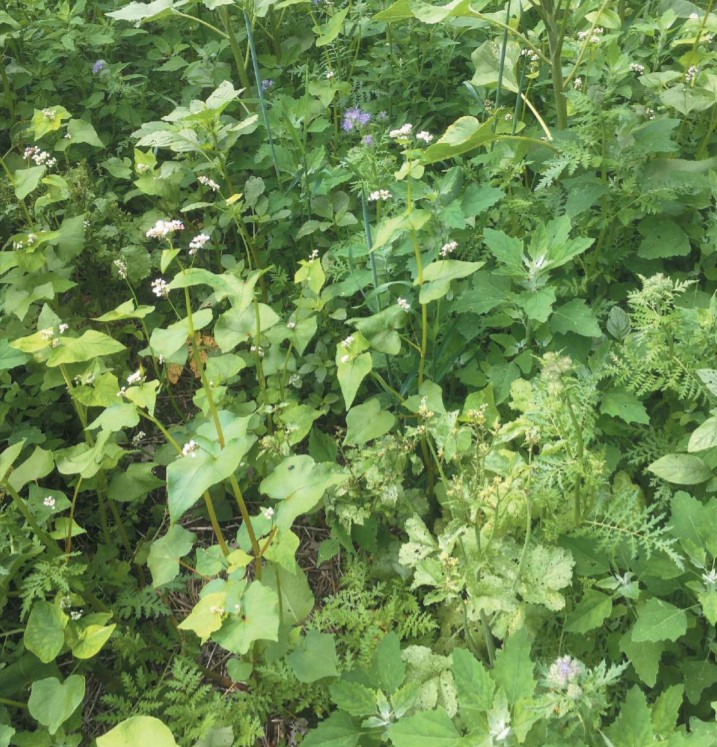 Plant cover, permanent cover, semi-direct cover, CIMS, CIPAN, erosion, soil fertility, intercropping.
Plant cover, permanent cover, semi-direct cover, CIMS, CIPAN, erosion, soil fertility, intercropping.

In agriculture, the term "cover crops", in its broadest sense, has long referred to : A"group of plants covering the soil permanently or temporarily, and whose main agronomic objective is to protect the soil from erosion by wind and precipitation[1]
With the development of knowledge and the massification of agricultural practices, a much wider range of benefits is now attributed to plant cover crops. The nature of these benefits may vary according to various factors, such as the farm's technical and economic orientation, its technical itineraries and specific soil and climate conditions, or the farmer's objectives and the equipment at his disposal.
Main principles
Plant families
With a few exceptions (which will be discussed below), cover crops are generally made up of three plant families:
| Poaceae (formerly Grasses) | Brassicaceae (Crucifers) | Fabaceae (Legumes) |
|---|---|---|
 |
 |
 |
| Examples: Cocksfoot, Ray-grass, Moha, rye, oats, etc. | Examples: Fodderrape, mustard, fodder radish, camelina, fodder cabbage, turnips, etc. | Examples: Pea, vetch, alfalfa, faba bean, lupin, etc. |
Characteristics:
|
Characteristics:
|
Characteristics:
|
Establishment and categories
Plant cover is also classified according to the way it is planted:
- Temporary cover crops: as their name suggests, they occupy the soil of an agricultural plot for a short period during the season. This may be during the growing season (the main crop is superimposed on the cover crop), or during the intercropping period (the cover crop is planted and then destroyed during the period between two main crops ).
- Permanent cover crops: in contrast, these cover crops are intended to occupy the soil for one or more agricultural seasons.
The objectives of the various cover crops
The benefits of cover crops
Soil structure and erosion
Although the use of plant cover crops has diversified, their primary function remains as valid and important as ever: to provide protection against erosion and soil compaction. The difference between annual soil formation and natural erosion is on average less than 0.2 mm per yearMontgomery[2][3] It therefore takes at least 50 years to create 1 cm of soil. In contrast, uncovered soil can erode by more than 1 mm per year, leading to a sharp drop in soil fertility.
Cover crops prevent certain elements from escaping into the environment via run-off, leaching or volatilisation, and maintain the moisture content of the first horizons, since humus has a water retention capacity of 5 to 6 times its weight.
Generally speaking, plant cover also contributes to soil fertility by storing atmospheric carbon, thanks to the photosynthetic action of the plants that make it up. Later, when it is (at least partially) restored, it provides humus and increases the soil's organic matter contentLabreuche[4].
-
Fasciculated root system
-
Taproot system
When composed of plants with a"fasciculated" or"taproot" root system, it can also have an effect on soil structure: increasing microporosity and decompaction respectively.
Green manures
A green manure is a cover crop selected for the specific purpose of amending the soil or fertilising the following sales crop. These cover crops, which generally include leguminous plants that fix atmospheric nitrogen, are most often returned to the soil when they are destroyedM[5][6]
Biodiversity
On a more secondary level, plant cover crops can help to maintain biodiversity. They contribute to the spatial and temporaldiversification of crop rotation, to the heterogeneity of habitats and, to a lesser extent, to ecological continuity between environments. They are therefore a refuge and a source of food for the populations of numerous animal, microbial (with the accumulation of organic matter) and plant species. In fact, the composition of a cover is sometimes selected to attract certain beneficials or for its melliferous potential.
Recoverable cover crops
In contrast to the above objectives, some plant cover crops are more directly aimed at production: these are known as catch crops or double crops. Most often planted as intercrops, they can be used to produce fodder biomass (e.g. grazed cover crops) or biomass for energy production (CIVE: Cultures Intermédiaires à Valorisation Énergétique), as well as grain production for longer intercrops.
The benefits of intercropping
CIMS
The main objectives of intercropping plant cover crops are to cover the soil between sales crop cycles, and to provide the various services mentioned above during this period (protection against erosion, carbon storage, effect on soil structure, green manure effect, biodiversity refuge, etc.). When they can provide several of these ecosystem services, they are known by the acronym CIMS, which stands for Cultures Intermédiaires Multi Services.
NFIC
Among the CIMS include a particularly widespread category of cover crops: Nitrate-fixing intermediate crops (NFIC). They have a specific objective: to draw mineral elements from the soil in autumn (when mineralisation peaks) to prevent them leaching into groundwater. They are then returned to the soil when the next crop is sown, so that it can benefit from these elements that would otherwise have been "lost". In certain highly vulnerable areas (ZVN), this practice is made compulsory by the Nitrates Directive.
Smothering cover
Another service provided by intercropping cover crops is weed control. The introduction of smothering species in these cover crops provides strong competition to the development of weeds at the time when the plot is most sensitive.
Pest cycles, allelopathy and biofumigation
In the same way, certain species have characteristics that help to mitigate the risk of damage caused by the establishment of pests or diseases during intercropping. This is the case with biofumigant or allelopathic species. The aim here is to include these species in the cover crop, so that the toxic compounds they produce can be used to purify the soil when the cover crop is returned. In addition, diversifying the crop succession breaks the cycle of many bio-aggressors.
The benefits of using cover crops during the growing season
The agronomic benefits that can be attributed to plant cover crops are all the more valid for longer-term cover crops. This is an important factor in many farming systems where cover crops are grown in association with cash crops, as in the case of :
Perennial crops
Perennial crops such as vines or orchards, for which certain technical itineraries include plant cover on the rows or between the rows for various lengths of time (see the section entitled "Cover crops, sector by sector").

Permanent cover and direct seeding
For annual crops, however, there is a range of practices borrowed from conservation agriculture, where the vegetation cover of the soil is permanent or almost permanent. It is also considered that the benefits listed above are multiplied when the cover remains intact for longer, and if the soil is worked lessDimassi[7]: maintaining a living cover for a period of 6 to 8 months during intercropping could enable the sequestration of 126 kg of C/ha/year [8] In the most advanced forms of these technical itineraries, the sales crops are sown directly through the canopy, known as direct sowing under (live) plant cover.
Establishing cover crops
The composition and sowing techniques for plant cover depend on whether it is permanent or temporary, and on the objectives set out above.
When choosing and planting a cover crop (guide), a number of aspects need to be taken into account, including crop succession, which determines the types of crop preceding and following the cover crop, and the date of planting. We can also take into account regulations and secondary objectives (recovery, biodiversity, green manure, etc.). The composition of the cover crop can also be chosen according to the limitations of the farm's equipment.
Plant cover sowing (guide) can be carried out at various stages of earliness and with different equipment For example, broadcast sowing followed by stubble ploughing or rolling to increase seed-to-soil contact. Or sowing under the cut, or even sowing directly into the stubble of the previous crop for early sowings.
Destroying cover crops
In addition to chemical action, there are several ways of destroy plant cover. This section provides an overview of existing techniques, regardless of the sector. For more technical information on the choice of techniques, please consult our dedicated guide: Destroying plant cover (guide).
Mechanical solutions
Plant cover can be destroyed mechanically using tools that work the soil at varying depths. In descending order, these are ploughing, stubble ploughing, shredding and rolling.
Biotic solutions
Biotic solutions for destroying plant cover are fairly limited, and sometimes insufficient to achieve complete destruction. However, destruction by frost and grazing can at least significantly reduce the biomass of the canopy at low cost.
Other solutions
Apart from those mentioned above, there are other (less common) solutions for destroying plant cover. These include thermal or electric weeding, or solarisation for vegetable crops grown under glass.
Keeping plant cover alive and regulating it
It is possible not to destroy the cover crop but to regulate it while the sales crop is in place. This is known as permanent cover. This means that the soil is covered immediately after the crop is harvested and the soil is not left bare. When the next crop is planted, the cover crop will need to be regulated so that it does not take over the crop.
Disadvantages and cost of cover crops
Disadvantages
- Cover crops are a new cropping system that you need to learn about.
- They can entail additional costs if the seed is expensive or if you increase the number of tillage passes.
- A great deal of technical expertise is required to obtain the desired results: higher yields and lower costs. This takes time.
- New tools are sometimes very useful for implementing these new technical itineraries (seed drills with opening discs, rotary clod clearers, no-till seeders, etc.). These tools are not necessarily available.
- They are easier to install and destroy in direct seeding systems. However, direct seeding is currently underdeveloped. Plant cover is therefore a promising technique, but one that still needs a lot of fine-tuning if it is to be as effective as possible.
Cost of a cover crop
Preparation
- Ploughing: €42/ha
- Rolling: 12 €/ha
- Stubble ploughing: 16 €/ha
Sowing
- Seeding (cereal drill): 21 €/ha
- Combination sowing: 39 €/ha
- Broadcast sowing: 10 €/ha
- Seeding (TCS drill): 32 €/ha
Destruction
- Shredding: 28 €/ha
- Spraying + glyphosate: 20 €/ha
Example of a technical itinerary
- 2 stubble ploughings + cereal drill + shredding = €81/ha
- Direct drilling + shredding = €52/ha
Plant cover, sector by sector
In this section you will find links to each of the "production" portals dedicated to plant cover:
- Vine: Plant cover in viticulture.
- Arable crops: Management of plant cover in arable crops.
- Multi-crop livestock farming: Plant cover for grazing.
- Market gardening: Introducing intercropping plant cover in vegetable production (practical guide).
Further information
Managing plant cover crops - Agroleague
Sources
- ↑ "G. W. Langdale et al, Cover crops effects on soil erosion by wind and water, 1991. http://citeseerx.ist.psu.edu/viewdoc/download?doi=10.1.1.514.9458&rep=rep1&type=pdf.
- ↑ D. R.; 2007.
- ↑ Soil erosion and agricultural sustainability, USDA, U.S. Department of Agriculture, PNAS Direct Submission, Vol 104, No 33.
- ↑ J. et al, Cultures intermédiaires Impacts et conduites, Arvalis institut du végétal, p23, 2011.https://www.arvalisinstitutduvegetal.fr/vient-de-paraitre-cultures-intermediaires-impacts-et-conduite-@/view-1873-arvstatiques.html
- ↑ .
- ↑ Thromas et al. Dictionnaire d'agroécoloie, Engrais verts définition, 2018. https://dicoagroecologie.fr/encyclopedie/engrais-vert/.
- ↑ et al., Long-term effect of contrasted tillage and crop management on soil carbon dynamics during 41 years, Agriculture, Ecosystems & Environment, Volume 188, Pages 134-146, 2016. https://www.sciencedirect.com/science/article/abs/pii/S0167880914000942
- ↑ Pellerin S. et al., Stocker du carbone dans les sols français, quel potentiel au regard de l'objectif 4 pour 1000 et à quel coût? Synthèse du rapport d'étude, INRA, 114P, 2019. https://www.inrae.fr/sites/default/files/pdf/etude-4-pour-1000-resume-en-francais-pdf-1_0.pdf.
Appendices
- Redirect Modèle:Pages liées

